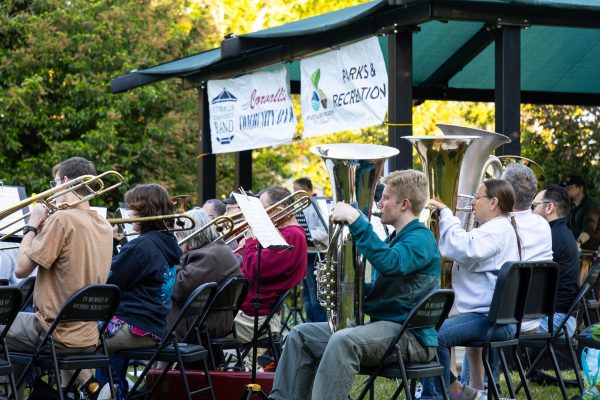Corvallis joins over 150 protests worldwide against Iranian government
Protesters in solidarity with Iranian citizens outside the Corvallis Courthouse Saturday. After the death of Masha Amini, Iran’s government has killed 83 peaceful protesters.
October 2, 2022
“‘Woman. Life. Freedom.’”
Anyone walking by the Benton County Courthouse on Saturday morning could’ve clearly heard this phrase being chanted by a group of people protesting for women’s rights in Iran, following the death of Mahsa Amini.
A 22-year-old Iranian, Amini had been arrested for allegedly not following the dress code for women by the Morality Police of Iran earlier this month. Allegedly falling into a coma as a result of police brutality — backed my multiple witnesses — Amini would end up dying on Sept. 16.
Despite attempts being made by the Islamic Republic to contain protesting, which included shutting down the internet in the country, the protests spread outside of the country leading to the one held Saturday morning.
Joined by over 150 protests worldwide today, they were all organized as part of a movement headed by an Iranian activist, Hamed Esmaelion whose wife and daughter were killed in PS752 by the Islamic Revolutionary Guard Corps of Iran in early 2020.
“[Amini] was detained. She was beaten to death in custody and then she died a week after that due to brain injury. After her death, they mentioned that she died by accident, she had some health issues and because of that she died,” said Director of Online Programs and Senior Instructor at Oregon State University, Lily Ranjbar.
According to Ranjbar, who was born and raised in Iran, it’s not just the Iranian president, Ebrahim Raisi, who is being protested but the whole system.
“I got detained by the morality police three times in Iran,” Ranjbar said. “I was scared to death. They were pulling me and they wanted to just put me in a big van. They just get Iranian women and put them in the van and send them to some center.”
These so-called education centers are where people accused of breaking the policies of the Morality Police are sent to be re-educated.
“We have been fighting the mandatory hijab, because that’s the most visible symbol of this religious dictatorship, but it goes beyond that,” said one Iranian OSU student. “The laws in the Islamic Republic actually are based on the Islamic laws, that means a woman’s life is literally quantified as half the life of a man.”
According to this student, deals such as the Nuclear Deal under the Obama Administration, should have helped the Iranian people, because sanctions on Iran would be loosened.
Instead the loosened sanctions and the increased money flow into the country only benefited the government and the 50+ terrorist organizations that Iran has been and continues to support.
Iranian graduate student at OSU Arash Sanadi believes that almost all Iranian citizens oppose the Iranian government.
“These issues have been going on for more than 40 years now, since the Islamic Revolution,” said retired Corvallis resident Masoud Zavarehi.
For Zavarehi who emigrated from Iran in 1990, things have changed drastically for the worse in Iran.
“We had freedom. It was a progressive country, and it was just starting to become modernized,” Zavarehi said. “And then came the Islamic Revolution that pushed back the country 50 years. Now women don’t have certain rights, women can’t have certain jobs.”
Women have become second-class citizens, says Zavarehi, and their issues are also human-rights issues.
“[Protestors] say women, life, freedom, because women are the essence of life. Then, of course, freedom,” Zavarehi said. “They want to have their choice on their body and their way of life. Unfortunately, this has been denied from them for a long, long time. It’s overdue.”


























































































































Mitra • Oct 3, 2022 at 3:22 pm
Thanks for your support.